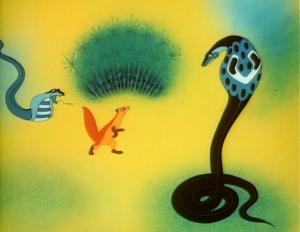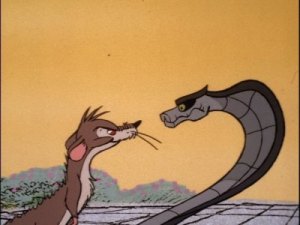A friend of mine is currently working on some illustrations for a Rikki Tikki Tavi book. I mentioned that, as a child, the 1975 Chuck Jones animated short film was one of my favorite things to watch. She is also a fan, and pointed me to an earlier version created in 1965 by the Soviet animation studio Soyuzmultfilm. I am a big fan of Soviet animation such as Hedgehog in the Fog, Nu Pogodi!, and Mystery of the Third Planet, so it was a perfect match.
Being much more of an artist than I, she did tell me that both films used a lot of yellow ochre, especially for the sky. This was the only bit she found particularly frustrating, and mentioned it was amusing that terrible sky colors managed to cross ideological lines during the cold war.
The two films are both about 30 minutes each, and follow the same general story: the mongoose Rikki Tikki gets taken in by a family after nearly drowning, and has to confront the cobra pair Nag and Nagaina, who seek to drive the family from their home and be rid of the mongoose.
The approach is rather different. The Jones film is much closer to the Kipling story. The family is white and British, settled in India, and many parts of the film largely focus on the relationship between Rikki Tikki and the family.
Soyuzmultfilm’s version, however, makes the family Indian, and spends a lot more time dealing with the animals in the garden. As my friend and I discussed, the choice to have a native Indian family appears to be a direct blow against British imperialism, which naturally the USSR had a vested interest in not promoting. I think it was a great choice, personally.
Jones’s version is narrated by Orson Welles, while the SMF film has no narration. Welles delivers several lines from the short story itself, including one about how “every good mongoose wishes to be a house mongoose”. There is apparently a reasonable amount of scholarship on the subject of the story being a piece of imperialist propaganda, which makes a lot of sense coming from Kipling. To Chuck Jones’s credit I don’t feel that is a focus of the film, but it certainly comes across more clearly than the subversive Soviet adaptation.
The film from my childhood holds up well in terms of animation. Obviously I am more aware and critical of the subtext, but as I said I feel the film doesn’t linger on it as much as the actual short story. I was delighted with my friend for sharing the Soviet film with me; it has been added to my bookmarks and watched several times already. I was able to introduce my sister to the Chuck Jones short, which made me happy, and even managed to involve her in a brief discussion about the politics behind it.
Anyway, check out some of the films above. I highly recommend them. Until next time, I’ll see you in 500 words.


